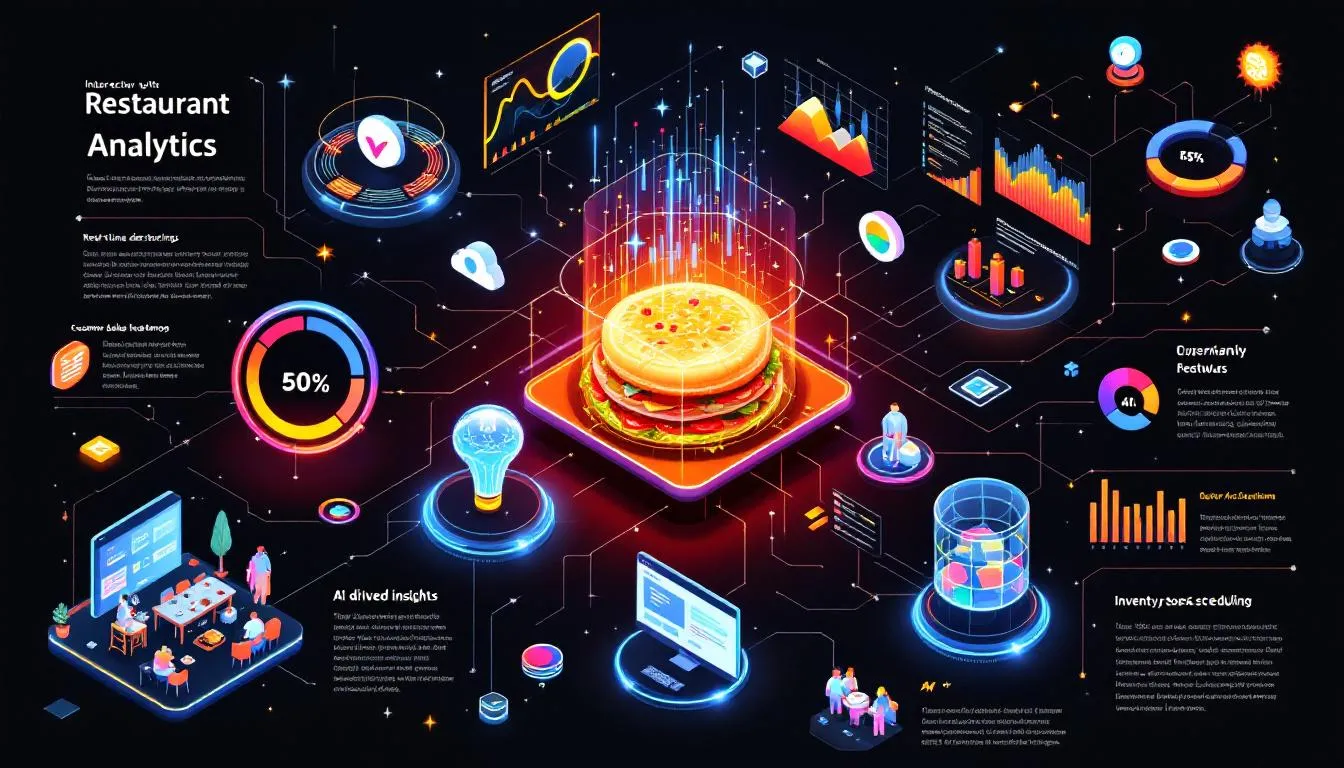The main reasons include high no-show rates, unpredictable dining times, and higher operational costs. In this article, we will explore why restaurants don’t take reservations and how these factors affect a restaurant’s choice to go with a walk-in-only policy.
Key Takeaways
-
Restaurants often avoid reservations due to high no-show rates, unpredictable dining times, and increased operational costs, favoring walk-in policies instead.
-
Walk-in dining promotes faster table turnover, improved customer flow, and greater flexibility in seating arrangements, enhancing overall operational efficiency.
-
A hybrid model combining reservations and walk-ins can optimize restaurant operations, catering to both spontaneous diners and those who prefer planning ahead.
The main reasons restaurants avoid taking reservations
.webp?width=640&height=366&name=8696f84f-acba-45f8-b44a-d46276c1a36a%20(1).webp)
There are several advantages for restaurants that avoid taking reservations. High no-show rates, unpredictable dining times, and increased operational costs are some of the main reasons. Many restaurants find that managing reservations distracts from the dining experience, leading them to prefer walk-in policies.
Casual restaurants and trendy establishments often thrive with walk-in only seating in a busy restaurant, which consistently fills tables.
High no-show rates
No-shows are a common issue in restaurants that accept reservations, causing operational inefficiencies and lost revenue. When customers don’t show up, the restaurant misses out on potential income and must deal with empty seats. As a result, many establishments no longer take reservations. Some have even implemented no-show fees or deposits to mitigate this issue.
However, a walk-in-only approach eliminates these risks, ensuring tables are always occupied and revenue is maximized.
Pro tip
Eat App can help reduce no-shows by allowing you to take upfront payments for reservations. This ensures that guests are committed to their bookings, making them less likely to cancel last minute.
Plus, with customizable cancellation policies, you can protect your restaurant from lost revenue while providing your customers a smooth, reliable experience.
Unpredictable dining times
Unpredictable dining times can wreak havoc on a restaurant’s schedule. When customers with reservations arrive late or take longer than expected, it disrupts the seating of new customers. This leads to a backlog, affecting the overall dining experience for other patrons.
Fine dining restaurants, in particular, face challenges with tardy diners, which can lead to vacant but reserved tables and longer waiting times. A no-reservations policy can mitigate these issues by promoting a first-come, first-served approach that keeps the dining room flowing smoothly.
Pro tip
Eat App helps manage unpredictable dining times by providing real-time reservation management and waitlist features. It allows you to adjust seating availability dynamically, so you can better accommodate guests even during peak hours.
With automated reminders and estimated wait times, you can keep guests informed and ensure a smoother, more efficient dining experience.
Increased operational costs
Managing reservations often necessitates additional staff and technology resources, which increases operational expenses. Restaurants must hire extra staff to handle bookings and customer inquiries, leading to higher payroll costs. Moreover, investing in technology solutions to manage reservations adds to the overall expenses.
This combination of increased staffing and technology investments can significantly impact a restaurant’s bottom line.
Pro tip
Eat App helps reduce operational costs by automating reservation management and guest communication, reducing the need for additional staff.
With features like online booking, automated reminders, and waitlist management, restaurants can streamline operations and cut down on labor and technology expenses, ultimately improving profitability.
How walk-in policies benefit restaurants
Walk-in policies offer numerous advantages for restaurants, from faster table turnover to improved customer flow and enhanced flexibility. Without the constraints of a reservation system, restaurants can serve more customers and significantly increase foot traffic.
This approach encourages diners to visit spontaneously, which can promote diners' overall sales and operational efficiency.
Further reading
Faster table turnover
Walk-in seating allows restaurants to avoid delays associated with reservations, leading to quicker table turnover. Without the need to hold tables for late or no-show customers, restaurants can seat new guests as soon as a table is available, maximizing revenue potential.
This results in a higher table turnover rate, allowing more diners to be accommodated within shorter time frames.
Improved customer flow
A steady influx of walk-in customers helps minimize idle time for tables and maintains a vibrant atmosphere. This continuous flow ensures that tables remain occupied, promoting a more dynamic and lively dining environment.
Effective walk-in policies can thus enhance the overall customer experience by reducing the time tables are left vacant between guests.
Enhanced flexibility
Walk-in policies provide greater flexibility in seating arrangements, allowing restaurants to adapt to real-time demand. This adaptability is crucial for managing varying group sizes and customer preferences.
Without a rigid reservation schedule, restaurants can accommodate spontaneous diners and maximize seating capacity.
Pro tip
Eat App helps manage walk-ins by providing an easy-to-use waitlist system. It allows guests to join the waitlist digitally so they can see real-time updates and avoid long queues.
This feature helps you efficiently manage seating, reduce wait times, and turn walk-ins into loyal customers while maintaining smooth operations.
Challenges faced by walk-in-only restaurants
While walk-in policies offer several benefits, they also present challenges such as longer wait times, customer dissatisfaction, and difficulties in staff allocation. These issues can impact the overall dining experience and operational efficiency of a restaurant.
Longer wait times
Peak hours at popular walk-in restaurants can lead to extended waiting periods, which can negatively affect customer satisfaction. Long wait times can deter keen diners from visiting, especially during busy times. The absence of reservations means that customers may need to wait in line for hours, which can be frustrating and inconvenient.
Customer dissatisfaction
Frequent long waits can lead to a negative perception of the restaurant, driving potential customers to seek alternatives. This dissatisfaction can be particularly pronounced among senior citizens or those with limited time.
Effective management and clear communication can help mitigate these issues, ensuring a smoother customer experience.
Difficulty in staff allocation
Walk-in-only policies make it challenging to predict customer flow, complicating staff scheduling. This unpredictability can lead to either understaffing during busy periods or overstaffing during quiet times, affecting operational efficiency.
Balancing staff allocation becomes crucial to maintaining a high level of service and ensuring repeat business.
Further reading
Balancing walk-ins and reservations
%20(1).webp?width=640&height=366&name=8696f84f-acba-45f8-b44a-d46276c1a36a%20(1)%20(1).webp)
A balance of walk-ins and reservations can optimize restaurant operations and boost customer satisfaction. A reservation system, such as Eat App, can help manage customer needs. It also offers smart options for walk-ins.
This approach allows restaurants to cater to both spontaneous diners and those who prefer to plan ahead.
Implementing partial reservations
A hybrid model of seating can improve customer satisfaction by allowing for both spontaneous dining and managed reservations. Setting aside specific tables for walk-ins creates a welcoming environment for those who prefer not to reserve in advance.
This mix of accepting reservations and walk-ins can maximize seating efficiency and ensure a balanced guest experience.
Utilizing technology
Advanced reservation systems, like Eat App, enable restaurants to manage their bookings more efficiently through a restaurant reservation system. These systems can send confirmation messages and reminders, significantly reducing no-show rates.
By optimizing reservation management, restaurants can better allocate staff and improve service quality.
Encouraging off-peak dining
Offering incentives for off-peak dining, such as discounts or special menu items, can attract customers during slower periods. Promoting off-peak dining helps manage customer flow and reduces congestion during peak times.
This strategy can lead to more balanced service and an improved patron dining experience.
The impact of reservation policies on different types of restaurants
%20(1).webp?width=640&height=366&name=d783bad6-2fe5-470e-918e-14c720f32f05%20(1)%20(1).webp)
Different types of restaurants adopt various reservation policies depending on their service style and target clientele. Fine dining establishments, casual dining spots, and busy urban restaurants all have unique needs and challenges regarding their reservation policy.
Understanding these differences is crucial for optimizing operations and customer satisfaction.
Fine dining restaurants
Fine dining restaurants often require restaurant reservations to maintain a high-quality dining experience. These establishments use reservations to prepare for specific guest needs and ensure personalized service.
Controlling guest flow through reservations helps fine dining venues maintain exclusivity and high standards.
Casual dining and cafés
Many casual dining restaurants and cafés adopt walk-in policies to foster a laid-back atmosphere and accommodate spontaneous dining. This approach helps reduce wait times and creates a more relaxed environment for guests.
Walk-in policies are particularly effective in casual settings where the focus is on convenience and flexibility.
Busy restaurants in urban areas
Busy urban areas typically see a higher influx of customers, leading to varied dining patterns. Many restaurants in these settings adopt a mix of reservations and walk-in policies to accommodate demand. This approach allows for a more dynamic customer flow and helps manage long queues during peak times.
Utilizing technology to track customer traffic patterns can further enhance seating efficiency and service quality.
Case studies: successful implementation of walk-in policies
%20(1).webp?width=640&height=366&name=f4ca7ecb-7a8b-47b3-926a-d92f77b82d1e%20(1)%20(1).webp)
Real-world examples highlight how different restaurants have successfully implemented walk-in policies. From popular bistros to trendy cafés and fine dining establishments, these case studies provide valuable insights into effective strategies and their outcomes.
A popular bistro’s approach
A popular bistro decided to stop taking reservations, which initially seemed risky but ultimately resulted in increased revenue. Eliminating reservations allowed the bistro to serve more customers during peak hours and reduce wait times.
The walk-in-only policy fostered a vibrant atmosphere that attracted even more diners, enhancing the overall dining experience.
A trendy cafe’s strategy
A trendy cafe leverages walk-in policies to cater to a steady flow of customers, enhancing overall satisfaction. Faster table turnover allows the café to serve more customers in a shorter time, maximizing revenue. Effective management of long queues and clear communication help mitigate customer dissatisfaction, ensuring a positive dining experience.
Further reading
A fine dining restaurant’s hybrid model
A fine dining establishment successfully combines reservations with walk-ins, allowing for more flexibility and a tailored dining experience. This hybrid model ensures high customer service standards while maximizing table availability.
By integrating both reservations and walk-ins, the restaurant caters to various customer preferences, improving overall satisfaction.
Summary
In summary, there are several reasons why restaurants may choose not to take reservations, from high no-show rates to increased operational costs. Walk-in policies offer benefits like faster table turnover and improved customer flow but also come with challenges such as longer wait times and difficulties in staff allocation. Balancing walk-ins and reservations can optimize operations and enhance customer satisfaction. Different types of restaurants have unique needs and strategies for managing reservations. Real-world case studies demonstrate the successful implementation of walk-in policies, highlighting the importance of flexibility and effective management.
Frequently Asked Questions
Why do some restaurants stop taking reservations altogether?
Some restaurants stop taking reservations to reduce no-show rates, manage unpredictable dining patterns, and minimize operational costs. This approach can streamline operations and enhance the guest experience.
How do walk-in policies benefit restaurants?
Walk-in policies benefit restaurants by enhancing operational efficiency and promoting a steady flow of customers, which allows for greater flexibility in seating arrangements. This approach ultimately improves the overall dining experience.
What are the challenges of a walk-in only policy?
A walk-in only policy can lead to longer wait times and customer dissatisfaction, as well as challenges in efficiently allocating staff due to unpredictable customer flow. It is crucial to manage these dynamics to enhance customer experience.
How can restaurants balance walk-ins and reservations?
To effectively balance walk-ins and reservations, restaurants should implement partial reservations and utilize advanced reservation systems while encouraging off-peak dining. This approach helps optimize table turnover and enhances the dining experience for all guests.
How do different types of restaurants handle reservations?
Different types of restaurants handle reservations based on their dining experience; fine dining usually requires them for a more tailored experience, while casual dining often welcomes walk-ins for a relaxed vibe, and urban spots may adopt a hybrid approach to balance demand.















-1.png?width=1812&height=1072&name=TripAdvisor%20%26%20More%20Bookings%20(1)-1.png)
-2.png?width=1812&height=1072&name=Google%20Bookings%20(1)-2.png)


-1.png?width=200&name=TripAdvisor%20%26%20More%20Bookings%20(1)-1.png)
-2.png?width=200&name=Google%20Bookings%20(1)-2.png)
-1.png?width=200&name=Instagram%20Bookings%20(1)-1.png)
-1-png.webp?width=200&name=Facebook%20Integration%20Rectangle%20(1)-1-png.webp)







.webp?width=200&name=download%20(1).webp)
%20(1)-2.webp?width=200&name=Eat%20(34)%20(1)-2.webp)
%20(1)-2.webp?width=200&name=Eat%20(18)%20(1)-2.webp)





.webp?width=670&height=440&name=8696f84f-acba-45f8-b44a-d46276c1a36a%20(1).webp)

.webp?width=314&height=175&name=undefined-Nov-13-2025-10-01-55-9751-AM%20(1).webp)




.webp?width=144&height=72&name=Eat%20App%20Logo%20(3).webp)